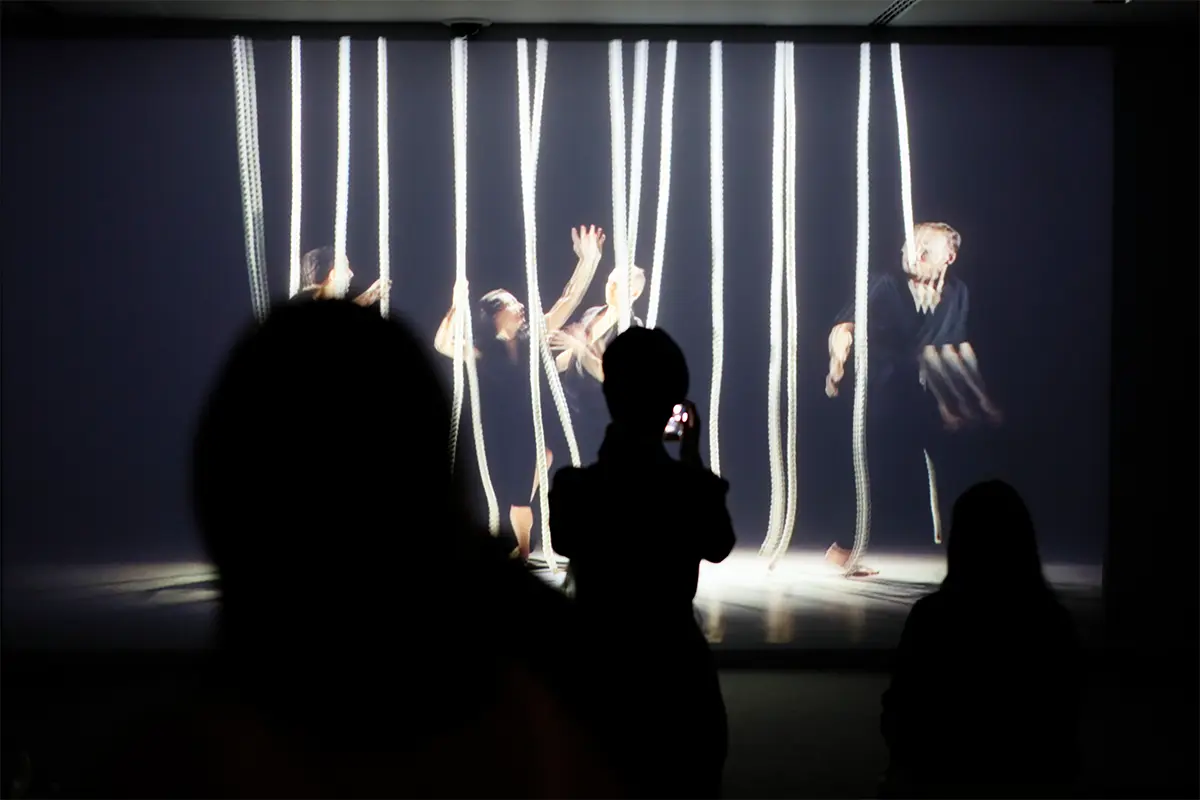
Hussein Chalayan, Souffleur: Pretension, Fake Celebrations, Post-Colonial Bodies
«Digital life in itself is a consumed situation where we become digital creatures and hide behind our digital self» – Hussein Chalayan presents his solo exhibition to Lampoon
Lampoon Interview – Hussein Chalayan presents Souffleur (Prompter)
Throughout his career, fashion designer and artist Hussein Chalayan has embraced dualities, constantly exploring the metamorphosis of the human body, perceiving it as an entity that finds itself in continuous movement, shape-shifting to adapt to the changes it recognizes in society.
Chalayan’s latest study on the human body takes the form of Souffleur (Prompter in English), an exhibition which focuses on modern anthropology through the exploration of new media. In his solo exhibition, presented at the Sakip Sabanci Museum in Istanbul, Turkey, he takes the role of the prompter, examining the journey of one’s identity and body in the era of digitalization.
«I would say this is a continuation of my other works, it is the journey. The biggest difference here is the mediums, it is the first time that I am using, in an exhibition like this, garments made out of copper and also three-dimensional printing. The first time, I am mixing furniture and fabric in this way. I see it as a continuation of my other works but in new mediums», the artist explained.
The exhibition invites the audience to explore three series, beginning with Pre-tension, Fake Celebrations and Post-Colonial Body, along with the performance film titled Gravity Fatigue (2015) directed by Chalayan himself.
Chalayan’s exhibition Souffleur is open to visitors in Sakip Sabanci Museum in Istanbul, Turkey until 8 January 2023.
Pre-tension, the first of the Chalayan’s series of Souffleur
In his first series Pre-tension, Chalayan explores the concept of charades and falsehoods encountered heavily in popular culture that has become an inseparable part of people’s reality in the virtual world.
Though the word comes with negative undertones, meaning to appear disingenuous and as something not based on truth, Chalayan argues that the act of pretending may be a powerful tool to trigger creative and artistic developments, acting as a necessary catalyst that can help the audience look at the world in a more imaginative light.
Hence, for the first scene Chalayan finds his visual language in the voguing culture. Harnessing the highly stylized dance moves of the 1980s, the installation welcomes the audience with a set of voguing masks, each striking a different pose. Projected under various lights, every mask has gaps present on their surface, which act as make-up kits and tools to apply your make-up on.
«I didn’t do voguing but believe it or not, but clubbing was a big part of our lives in Central Saint Martins – Chalayan recalls – In one hand, we were studying hard and attending class… but I don’t think I ever went out so much in my life, than when I was a student. In London, in those days, it wasn’t gentrified yet, it was raw and quite dangerous and exciting. Observation of the body, in those environments, and sexual liberation was much part of our lives and we lived through it well».
Fake Celebrations – Souffleur by Hussein Chalayan
The idea of pretending directs Chalayan’s second scene which deals with the increasing role social media plays in our daily lives. Following a more cynical approach, Chalayan brings a critique to the digital isolation one encounters in the virtual world.
Titled Fake Celebrations, the artist mends his relationship with fashion and art to create a set of sculpted garments frozen in movement, ripping and tearing them apart to reveal materials that signify liberation such as glitter, confetti, sequins and feathers.
Torn from within, the garments are contained in frames while overlapping layers of patterns, movements and materials are projected on the sculptures, transforming the body into a celebratory vessel that stands in opposition to the digital world.
Hussein Chalayan to Lampoon on digital life and digital isolation
«Fake Celebrations came as a response to digital isolation. Digital life in itself is a vastly consumed situation where we become digital creatures and hide behind, in a way, our digital self. I don’t necessarily believe that our digital selves represent our reality. I think it is another form of masking. My view is that it can be exciting to be a digital being, but at the same time there is a loss of self that is happening and also isolation at the same time. I think digital identity as a question, for me generally, is a worrying question, at the same time depending on how it is used, it can be positive as well, in the sense that you can go in and out of different worlds much more quickly, you can reach people much more easily. It depends on how it is used».
The increasing digitalization of social life and dependence on information technologies have pushed the physical and virtual realities to merge further, creating multiple identities for individuals to step in and out of in a matter of seconds. As communication between individuals evolve from social media to the metaverse, the fashion industry plays a vital role in designing and dressing the avatars of our future selves.
On this subject, Chalayan, digital fashion is no longer a controversial topic, «There is not much I can say about it other than that it is part of natural evolution and we are going to be much more involved. Especially in gaming as well. You know, these ideas have existed years ago, but they become mass and more talked about after big companies like Meta, start to actually invest in it and make money out of it. I feel that metaverse and digital fashion are not new subjects, but they have become more popular subjects».
[envira-gallery id=”119421″]
Hussein Chalayan and the Postcolonial Body
In the last series Postcolonial Body, Chalayan uses the form of humanoid furniture to display the dance and bodily movements of ethnic groups, colonized by the West throughout history. Focusing specifically on South American and Japanese dance genres, Chalayan brings to attention how colonization can impact collective behavioral codes, manners and movements of the body.
«Postcolonial body is about how we physically present ourselves, how that was influenced by these colonizing forces. If you go to the Far East, the way you try to please the other is done in a certain behavioral way. Even when you greet the Queen in England, you are supposed to walk backwards, you are never supposed to turn your back towards her. So, there is a behavioral code».
The scene welcomes the audience into the furnished space, where each piece imitates the dance moves that were once used as a means of entertaining and protesting against the colonizers at the same time. The eye-catching vibrant textiles that are draped on the furniture like curtains, creating a division between the body on stage and body behind it.
«In the dance genres I was looking at, there was a sense of entertainment but also protest at the same time, which fascinated me, because they are in a conflict. When there is a force dictating you, you have to mix entertainment and protest together».
Souffleur – Digitalization as a new form of colonialism
As information technologies become inseparable parts of everyday life, they bring to question whether in the Age of Information, we are experiencing a new form of colonization through digitalization, one where the loss of reality and identity occurs in the physical sphere, perhaps replaced with the one that exists in the virtual.
On this aspect, Chalayan notes, «It is a form of control, there has also been so much talk about ourselves being marketing tools. So yes, in a way we are victims to the system but without questioning it. It is also a way of coming together and connecting. I think connectivity is what a lot of people are after, but in fact it is isolated connectivity.
I don’t know how much digital connectivity can stay with you and be part of your soil. But with digitalization, it is like fire, you either light up a room or you burn a room. This is how I see the digital world; it controls us but we can also control it if we don’t get lost in it and if we know how to be moderate with it, we can benefit from it… But I think a lot of people get lost in it».
Hussein Chalayan on the evolution of fashion
As a designer and artist who always perceived himself as an outsider, Chalayan observes the fashion scene today with comparison to his past, expressing «The biggest difference in fashion since I have started doing it is that fashion was not digital when I started and then it became digital. There was no such thing as celebrity status or celebrity fashion. You never had conglomerates investing in fashion like LVMH, Kering.
Neither did you have fashion designs become so accessible, affordable and quick to reach consumers in the past. So, these four things, celebrity fashion, digital fashion, conglomerates investing and high street fashion have changed the landscape. In some ways, fashion has become democratized, anyone can do fashion now, so why not? But the main thing I am critical of is, people interested in fashion need to understand the difference between designer fashion, celebrity fashion and high street fashion. My criticism is often that all of these branches are seen under the same umbrella and for me, they are different».
Chalayan further gives insight on the changes he observes in younger generations who are interested in fashion, arguing that due to the abundance of information available online, there is a lack of respect for creative input, «There are a lot of young people who look at fashion and don’t know fashion history. They see a design and don’t understand where it came from. Because we are not living in an era where information is respected, we are living in an era where information is just used.
When people are referring to designers, often they don’t even name them. For them it is just a means to an end, for them it is something to use at that moment. I guess, it is the lack of respect for information that I am critical of. So, for me, people in fashion should understand the movements, which designer did what and what was their significance».
Cultural Appropriation
With the democratization of information and the power given to users to express their opinions freely, another topic of discussion that has come forward within the creative industries is cultural appropriation.
On the subject, Chalayan notes, «Everyone has a right to express their opinion, but I think it is endless. It is the matter of following that gives people a voice. It is the way certain opinions become popularized and after it becomes popularized, it gets dramatized and there is a hype around it. With the hype, it becomes another level of reality. Cultural appropriation is something I have been talking about with my students all the time. Let’s say you are Turkish and you are interested in Indian clothing, you want to do a collection based on India… What’s wrong with that? Why shouldn’t you embrace Indian culture just because you are Turkish?»
However, Chalayan accepts the boundaries that come with appropriating different cultures, explaining «Of course, there are certain boundaries, once you exoticize something in a patronizing way, it can become problematic then. But it is always intention vs. result and how they are perceived. Some people misuse culture but at the same time, if you are somebody passionate about a culture and want to explore it, then you are honoring it and celebrating it. What’s wrong with that?»
Hussein Chalayan
Born in Nicosia, Cyprus and graduated from Central Saint Martins with a BA in Fashion. Chalayan established his own company in 1994. His cross-disciplinary approach towards fashion has always allowed him to see garments in a different light, sometimes from the point of view of a sculptor, a designer, an artist and even an engineer. Throughout his career, Chalayan’s work has dealt with disembodiment, migration, isolation and transformation.







